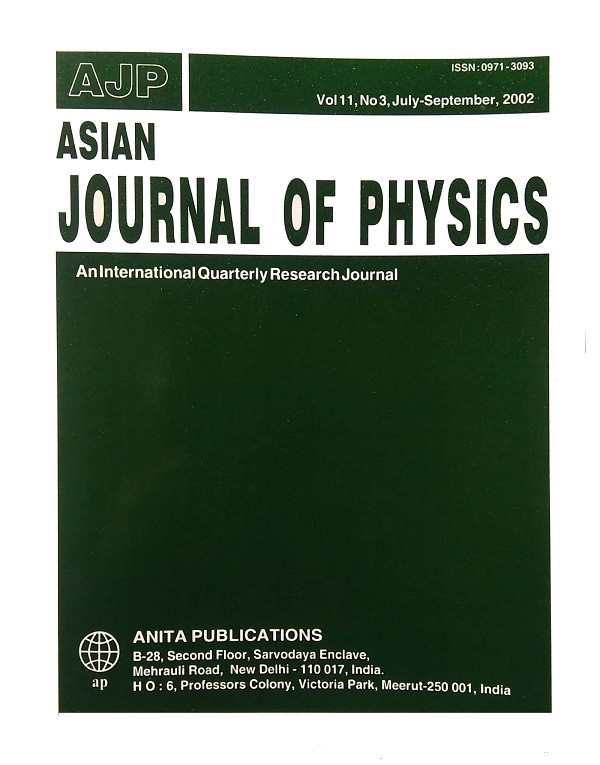Editor-in-Chief : V.K. Rastogi

ASIAN JOURNAL OF PHYSICS
An International Peer Reviewed Research Journal
Frequency : Monthly,
ISSN : 0971 – 3093
Editor-In-Chief (Hon.) :
Dr. V.K. Rastogi
e-mail:[email protected]
[email protected]
| AJP | ISSN : 0971 – 3093 Vol 11, No. 3, July-September, 2002 |
Asian
Journal of Physics
Vol 11, No. 3, July-September, 2002
Proceedings of The National Conference on Lasers & Spectroscopy
CONTENTS
|
Difference in adduct forming abilities of dithiophosphinato and
dithiocarbamato derivatives of Ni (II) : EHMO and Normal coordinate
analyses |
|
|
P K Gogoi and R Konwar |
265 |
|
Radon diffusion studies in some building materials using LR-115 plastic
track detector |
|
|
Surinder Singh, Ajay Kumar and Baldev Singh |
275 |
|
New inexpensive medical laser sources for skin treatments |
|
|
Abdallah M Azzeer |
281 |
|
Optical behaviour of some nematic liquid crystal mixtures |
|
|
Rajbir Singh, P P Anand, V K Agarwal, Jasjit Ahuja and K K Raina |
287 |
|
Crystal structure of 2-(3'-
nitropheny1)-3-14[3"-chloro-4"-fluoro)phenyl]-4-thiazolidinone |
|
|
K V Arjuna Gowda, M K Kokila, Puttaraja, M V Kulkarni and N C
Shivaprakash |
293 |
|
Study of asymmetrical antennas fed by Tee |
|
|
P V Hunagund, Sara Fatima Farida, R M Vani, S N Mulgi, P M Hadalgi and
G Jyoti |
299 |
|
Decay instability of a whistler in an inhomogeneous plasma |
|
|
Salil Das, P Saikia and D P Tiwari |
303 |
|
An investigation of the non-linear properties of correlation filter
synthesis and neural network design |
|
|
I Kypraios, R C D Young, P M Birch and C R Chatwin |
313 |
|
Optical Comparator based on FLC over silicon technology |
|
|
T D Wilkinson and N J New |
345 |
|
Similarity suppression algorithm for designing pattern discrimination
filters |
|
|
David R Selviah and Epaminondas Stamos |
367 |
Vol 11, No 3(2002) 313-344
An investigation of the
non-linear properties of correlation flter synthesis and neural netwok design
I Kypraios, R C D Young, P M Birch
and C R Chatwin
Industrial Informatics and
Manufacturing Systems Centre
School of Engineering
and Information Technology,Brighton BN1 9QT, United Kingdom
[email protected] (RCD Young)
Since the introduction of SDF correlation filters vast
amounts of work has been done on improving filters’ synthesis. Several
different variations of classic SDF filter have been suggested. The objective
is to create filters invariant to distortions from rotation, scaling,
translation and inclusion of noise. Recently, the use of wavelets as a
pre-processing stage of the images has been explored. Additionally, the
application of non-linear operations as part of the pre-processing stages seems
promising. This paper investigates those non-linear operations in filters like
NL-DOG SDF filter. We also discuss the newly introduced SDF-MACH filter in this
paper. Advances in artificial neural network architectures emerged their wide
availability in pattern recognition tasks. We have created a new
non-linear neural model able to input analogue patterns. This paper focuses in
exploring in detail how any non-linear operations are utilized in our model
comparatively to correlate filters. We mathematically prove the non-linear
superposition characteristics of the neural netwok. Finally simulation results
are given to demonstrate both, the inside synthesis of SDF type correlation
filters and the neural network design under the scope of those non-linear
operations. We do not intend to provide an analytical comparison of correlation
filters and neural networks rather to focus on the understanding of their
underlying working functions. ©Anita Publications. All rights reserved.
Total Refs : 30
Vol 11, No 3(2002) 345-366
Optical Comparator based
on FLC over silicon technology
T D Wilkinson and N J New
Cambridge University,
Engineering Department
Trumpington St, Cambridge CB2
1PZ,U K
Recent developments have shown that it is possible to
create an optical correlator, or comparator, based on ferroelectric liquid
crystal spatial light modulator technology. In this paper we present the
expansion of this idea to include an in-house FLC over silicon SLM that allows a
compact recognizer to be built. The basic architecture is the binary 1/f correlator
built around a high-speed 320 ×240 pixel FLC over silicon SLM. Such an
architecture can be built with low tolerance opto-mechanics to make a powerful
yet robust optical camparator.Experimental and simulation results from this
comparator are presented in this paper alongwith a discussion of how this
architecture can be used in more abstract recognition tasks such as motion
estimation instead of the more traditional ‘tank-in-the-bush’ scenarios. ©Anita
Publications. All rights reserved.
Total Refs: 20
Vol 11, No 3(2002) 367-389
Similarity suppression
algorithm for designing pattern Discrimination filters
David R Selviah and
Epaminondas Stamos
Department of Electronic and
Electrical Engineering
University College London,
Torrington Place, London, WC1E 7JE, U K
E mail [email protected]
The similarity suppression (SS) algorithm is
introduced which designs inner product correlator filters for optical pattern
recognition and discrimination. The algorithm which mutually orthogonalises two
sets of patterns is compared to the matrix design technique for Linear
Combination Filters (LCF) and is shown to converge to a similar set of filters.
Computer simulations for discrimination of a set of 32, 16 ×16 binary, bipolar
patterns demonstrate that the designed filters can tolerate 7 dB more noise than
matched filters for the same performance and the dynamic range required is
reduced by 25 dB making them suitable for use in optical correlators. Moreover,
filters designed after only 2 iteration were found to have much better
discrimination ability than LCFs in the important case of high noise and low
SNR. Their outer products were also found to be lower. © Anita Publications. All
rights reserved.
